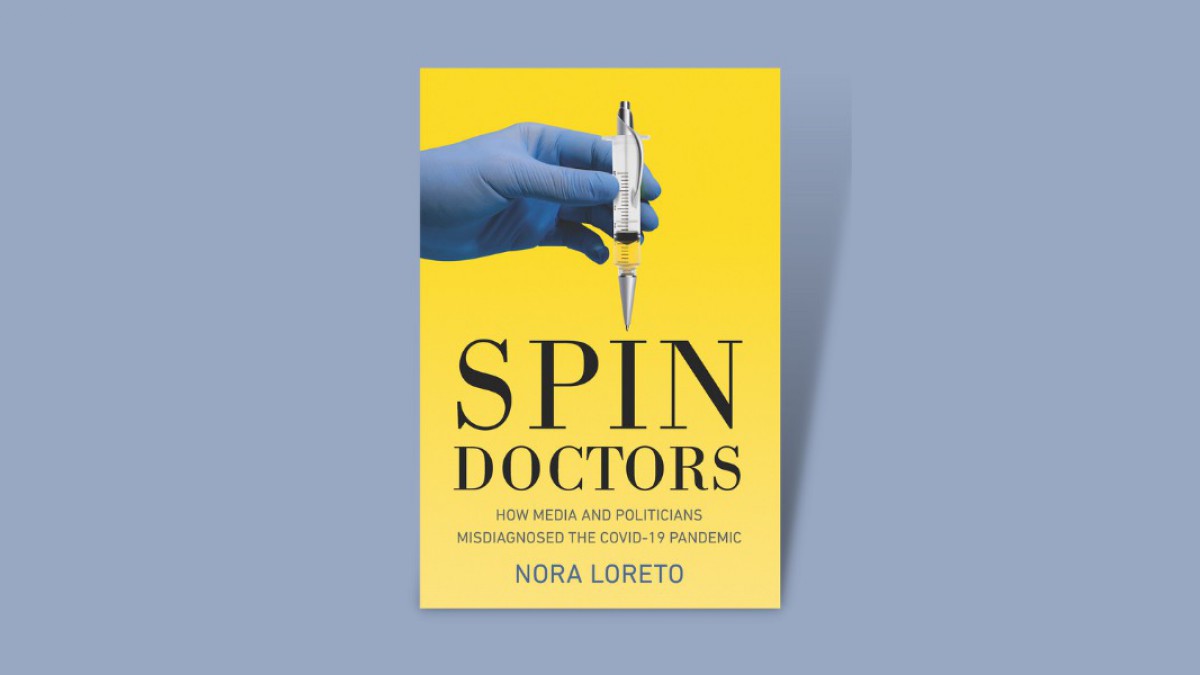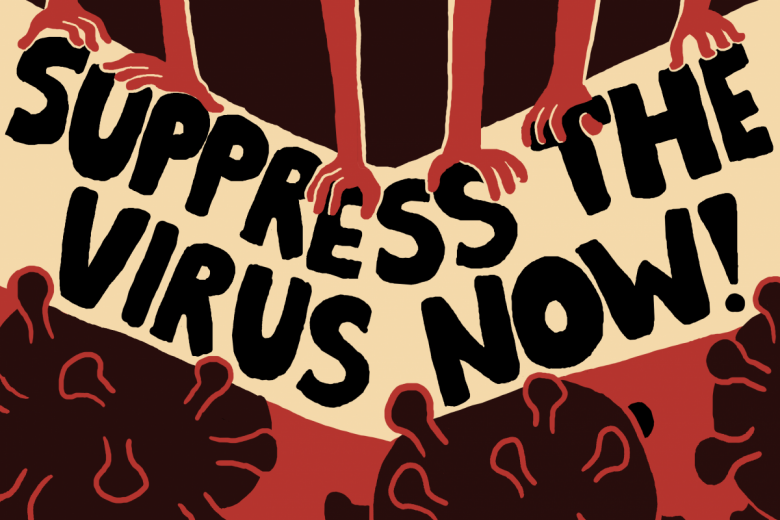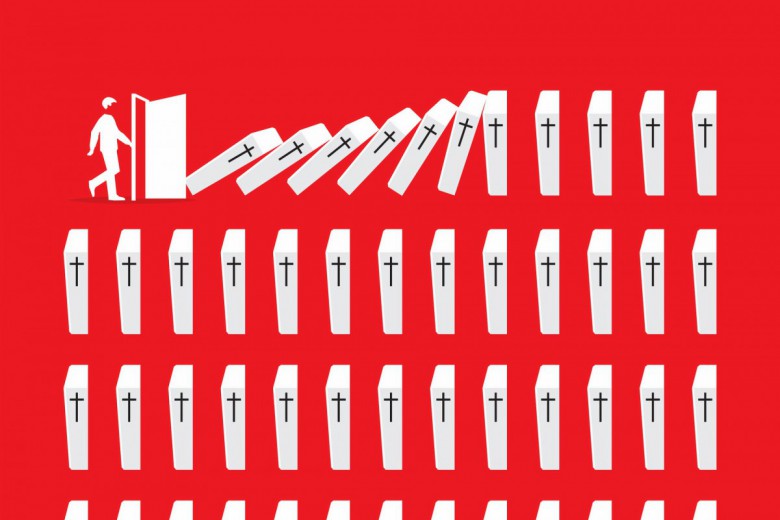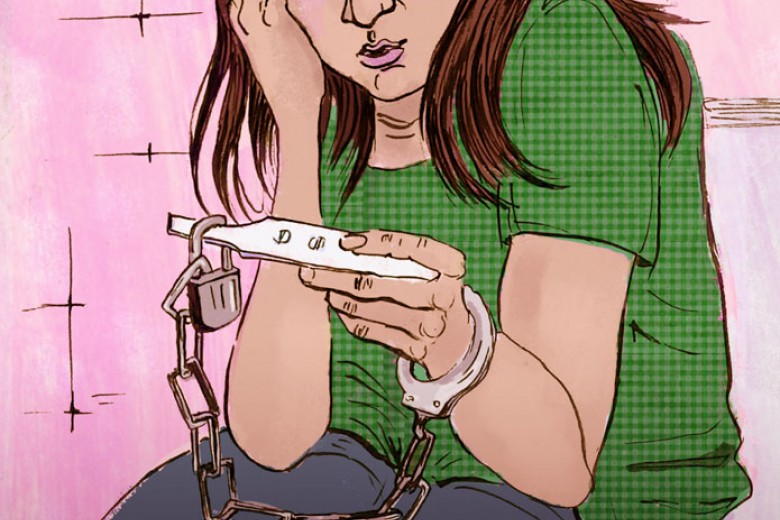As a nurse working on the front lines of the pandemic, I’ve seen first-hand my colleagues’ exhaustion and exasperation with anemic government responses and news reporting that calls us “heroes” without discussing systemic failures. The consequences for health-care workers are clear: burnout, mass resignations, constant understaffing, and patient harm. Poor public management of COVID-19, and a docile press, have cost workers in all sectors.
In her new book, Spin Doctors: How Media and Politicians Misdiagnosed the COVID-19 Pandemic, Quebec-based journalist Nora Loreto dissects the first 13 months of the pandemic in Canada – from March 2020 to March 2021 – by looking at government policies and press coverage. For example, in April 2020, she examines residential facilities; in May, food processing; June, racism; and July, “the lie of personal responsibility.” In his book The Skin We’re In, Desmond Cole used a similar month-by-month technique to generate a portrait of racism’s operations in Canada over the course of one year. The approach creates a personal connection for the reader – we cannot help but compare how we lived the month with how the month is written. In Spin Doctors, Loreto’s approach allows the reader to pick up a new lens with which to view the recent past.
The dominant argument in Loreto’s thick COVID-19 How-Not-To manual is that the Canadian governments and mainstream media failed to correctly identify COVID-19 as a threat to collective wellbeing that demanded collective solutions.
As Loreto recounts, since the beginning of the pandemic, governments have called on individuals to manage the crisis: wash your hands, don’t touch your face, wear a mask, stand six feet apart, and most importantly, stay home. I live in Nova Scotia, and here, former Premier Stephen McNeil’s April 2020 press conference appeal that we “stay the blazes home” became a cult hit, with spin-off folk songs, children’s books, and tacky merchandise. Canadians generally wanted to be helpful to the cause and, early on, were extraordinarily compliant – to the extent that they could be.
But it soon became clear that staying home is not a straightforward ask: what about the people without a home? The workers left without an income when their workplaces closed? The workers denied wages if they stayed home? Those who had to staff essential services, from grocery stores to emergency departments? And of course, when schools closed, how could kids stay home when their parents and guardians had to work outside the home? Without government support for basics – like housing, paid sick leave, and child care – hand sanitizer and plexiglass dividers proved inadequate, and COVID-19 spread rapidly through congregate living environments, workplaces, and schools.
The dominant argument in Loreto’s thick COVID-19 How-Not-To manual is that the Canadian federal and provincial/territorial governments and mainstream media failed to correctly identify COVID-19 as a threat to collective wellbeing that demanded collective solutions.
Individualistic solutions temporarily softened the blow for wealthy people while abandoning poor people to illness, disability, and death – ultimately prolonging the pandemic for everyone. The capitalist economy allowed work-from-home for well-paid office workers – the “laptop class” – while insisting poorly paid retail, manufacturing, and service sector workers continue to show up in-person or face financial ruin. Loreto identifies the drive for profit lying beneath this eagerness to meet COVID-19 with individualistic solutions.
But it soon became clear that staying home is not a straightforward ask: what about the people without a home? The workers left without an income when their workplaces closed? The workers denied wages if they stayed home?
Consider chapter two, “April 2020: Disaster in Residential Care.” Excluded from the Medicare basket of socialized health services, long term care is under-scrutinized and overly privatized, and as Loreto reveals, corrupted by government officials’ personal ties and investments. In the early days of the pandemic, Loreto began tracking COVID-19 infections and deaths in Canadian long-term care facilities. Based on her research, to date over 20,000 people have died in residential care facilities since the onset of the pandemic. No major news outlet made a similar effort to quantify the harm, nor did the mainstream media question how private ownership leads to corner-cutting with deadly consequences.
Similarly, Loreto shows how workplace COVID-19 outbreaks exposed cruel profit-driven employment practices. While whole neighbourhoods of people clanged pots from their balconies for the 7 p.m. hospital heroes’ shift change, many other types of essential workers faced poverty wages, dangerous shortages of personal protective equipment, and grueling conditions. Racialized and immigrant workers were most affected: for example, during the now-infamous outbreak at Alberta’s Cargill meat processing plant in 2020, nearly half of the 2,000-person workforce tested positive for COVID. Loreto remarks that it is no coincidence that most of Cargill’s workers are immigrants, refugees, or temporary foreign workers. Government shut-down orders failed to protect workers in the food-manufacturing sector, and media failed to call them out on it, or to identify the key role of racism in how COVID-19 was permitted to spread.
When mask mandates were widely implemented in the summer of 2020, and the race for the vaccine intensified in the fall of that year, government calls for individual responsibility met decidedly stronger resistance. As Loreto relates, COVID-19 exposed a marriage between white supremacist far-right groups and the anti-mask/vax movement. Governments underestimated the threat this alliance posed, and media was slow to make the connection, reporting on protests in ways that only served to validate and enflame this fringe. Loreto identifies a reliable pattern in articles about the “freedom” rallies: “broadcast the protestors’ demands uncritically, bury or exclude fact-checking, use a headline the movement could be proud of and neglect to write about who was actually organizing these events.”
As we move deeper into 2022, our third year of the pandemic, Loreto’s warnings merit more attention than ever – especially her concerns about the loss of independent, critical voices in mainstream journalism.
The book concludes in March 2021, at over 300 pages – but Loreto could easily have kept going into 2022 with the Spin Doctors assessment of COVID-19 mismanagement and miscommunication. For example, in summer 2021, municipal police forces destroyed homeless encampments in public parks at the very same time as housing prices skyrocketed and shelters – already dangerous sites of infectious disease transmission – were beyond full. Or in fall 2021, when vaccination was widely available, rather than require all public sector workers be vaccinated (a potentially politically unpopular approach), most provincial governments first downloaded vaccine mandate enforcement onto individual receptionists and wait staff in the retail and service industries. Or early winter 2022, when Omicron raged, and provincial governments kept schools closed or dared to re-open them, either way failing to ensure families had what they needed to stay safe. And most recently, in January and February 2022, when a convoy occupied Ottawa for three weeks, using vaccine opposition as a front for expression of white supremacy, heteropatriarchy, and class war. Again and again, Spin Doctors identifies consistently pro-business policies and an uncritical press, pushing us ever further from the culture of collective care and support needed to recover from this crisis.
Spin Doctors is a deftly researched, persuasive alt-memoir of Canada’s first year with COVID-19. As we move deeper into 2022, our third year of the pandemic, Loreto’s warnings merit more attention than ever – especially her concerns about the loss of independent, critical voices in mainstream journalism. Governments will continue to craft policies with varying levels of relevance to epidemiological evidence and with suspect impact on equity. Will journalists be able to call them out, and clear up dangerous and widely circulating misinformation? Or will the media continue to propagate the myth of individual risk and responsibility in what is a collective crisis?






_780_520_90_s_c1.jpg)
